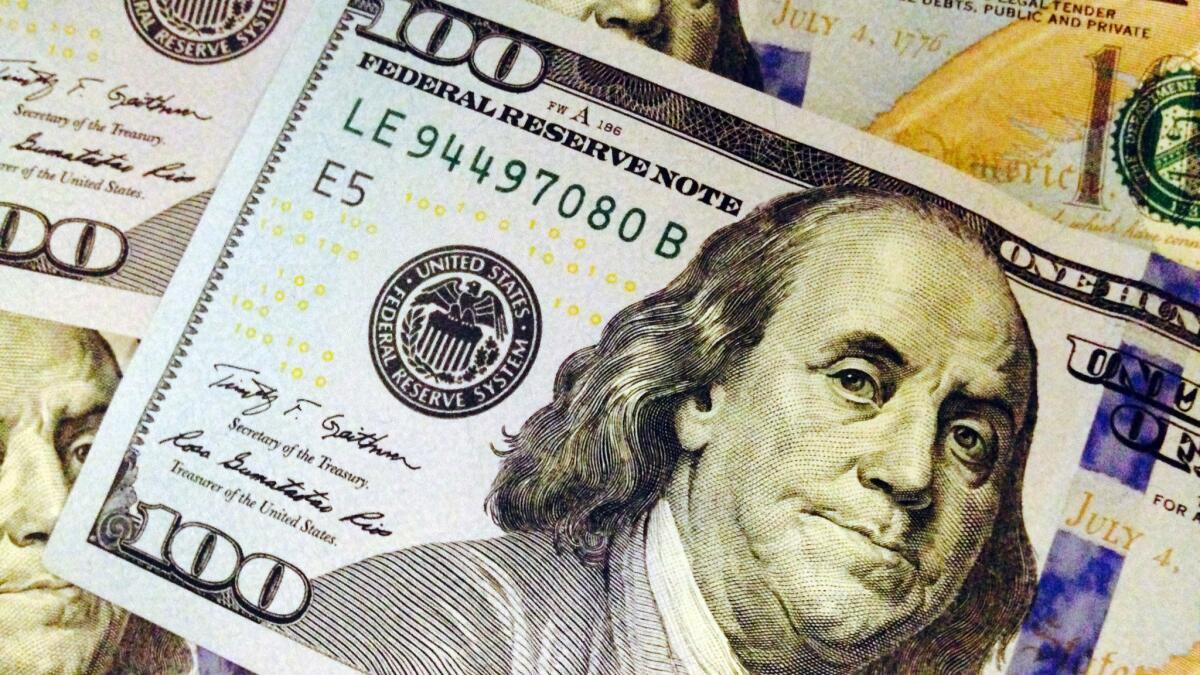Debate over retiring the $100 bill resurfaces with a surge in circulation

- Share via
A puzzling surge in the number of $100 bills in circulation and the planned demise of the 500-euro bank note have resurrected debate on the need for three-digit currency at all, given their favor with criminals around the globe.
A decade ago, the number of $100 bills lagged well behind $1 and $20 notes. But the tally has doubled since the end of the financial crisis, according to data from the Federal Reserve; by 2017 the C-note had eclipsed the dollar bill to become the most widely distributed U.S. currency. Output is still climbing, and experts are perplexed.
“It could be driven by a global fear of negative interest rates in Europe and Japan, or it could be a savings vehicle for U.S. households worried about another financial crisis, or it could be driven by more demand from the global underground economy,” Torsten Slok, chief international economist of Deutsche Bank, wrote in a note to investors last week.
The Benjamin Franklin-faced currency has been the largest U.S. bill since the $500, $1,000 and $5,000 were axed in 1969, but it’s not very popular for day-to-day transactions. The average American carries about $60 in cash, according to a 2017 study from the Federal Reserve Bank of Atlanta. A December study from Pew Research Center found that about 30% of Americans use no cash at all on a weekly basis, suggesting that, in the digital age, cash is going out of style altogether.
The U.S. Treasury Department is responsible for printing currency, and does so to replace bills that are old or damaged, or to meet increased demand. But the lifespan of $100 bills is about 15 years, compared with 8.5 years for a $50 bill, so they don’t need to be replaced very often.
The vast majority of the bills aren’t even here. A 2018 research paper from the Federal Reserve Bank of Chicago estimates as much as 80% of the 12 billion $100 bills in circulation reside outside the country. Some of this growth is likely a result of the U.S. dollar supplanting local currencies in unstable economic environments.
“We think that the significance of foreign demand is unique to the dollar,” Ruth Judson, an economist at the Fed Board of Governors, said in a 2018 paper from the Federal Reserve Bank of Richmond. “Other currencies are also used outside their home countries, but as far as we can tell, the dollar has the largest share of notes held outside the country.”
One possibility is an increase in global corruption and criminal activity. A 2016 paper published by Harvard’s Mossavar-Rahmani Center for Business and Government claimed that high-denomination notes are the “preferred payment mechanism” of criminals, because of “the anonymity and lack of transaction record they offer, and the relative ease with which they can be transported and moved.”
The Harvard paper, by Peter Sands, former chief executive of Standard Chartered Bank, puts the convenience of big bills for criminals in stark terms: $1 million in $20 bills would weigh more than 50 pounds. In 500-euro bank notes, it would come to a little over 2 pounds.
Though exact figures aren’t available, the amount of cash criminals launder each year could range from hundreds of billions of dollars to $1 trillion, the Financial Action Task Force, an intergovernmental body that combats illicit finance, said in a 2015 report. The U.S. dollar, the euro, the British pound and the Swiss franc are among criminals’ preferred currencies.
“In many cases, even when the proceeds of a crime are initially generated in electronic form (such as the theft of funds from a bank account), criminals choose to withdraw the funds from a bank account in cash, transport it to another country, and pay it into another account in order to break an audit trail,” the report said.
In the U.S., cash from regional narcotics sales is usually funneled to a central counting house in a large city, such as Atlanta, Boston, Chicago and Los Angeles, where smaller notes are converted into $50 and $100 bills and then vacuum-sealed to reduce their bulk, according the report.
Tougher banking controls against money-laundering may be driving criminals to rely more on cash, the report said.
It’s these arguments that led the European Central Bank to stop recirculating 500-euro bank notes, which are worth about $567. At one point, the bills were called “Bin Laden notes” because of their rumored use in financing terrorism and money laundering. There also has been a broader push to eliminate big bills everywhere.
“A global agreement to stop issuing high-denomination notes would also show that the global financial groupings can stand up against ‘big money’ and for the interests of ordinary citizens,” former Treasury Secretary Lawrence Summers wrote in a 2016 Washington Post op-ed in favor of killing off the $100 bill.
Plenty of law-abiding people still depend on cash. As of 2015 there were 2 billion adults worldwide who didn’t have access to banking services, making cash their only means of buying goods and services. Many of those people live in the world’s poorest countries.
Some experts believe that the staggering rise in $100 bills could reflect financial unease that’s causing some people to keep their assets outside the financial system. That same tension has fueled interest in cryptocurrency such as bitcoin.
Fears of a recession have been growing, in the United States and abroad. A recent survey of nearly 800 top business leaders around the world listed global recession as their biggest concern for 2019.
In an interview Monday, Summers, now a Harvard University professor, said he doesn’t buy the idea that recession fears are driving demand for $100 bills. “I know a lot of people who plan for the next financial crisis. I don’t know anyone who is holding a big hoard of hundred-dollar bills,” he said. “That suggests [the bills] are mostly being used as repositories of wealth for people who want to avoid taxes or who have committed crimes.”
He repeated his call to stop printing the bills. “I think the case is getting even stronger as the Europeans have eliminated the 500-euro note,” he said.
More to Read
Inside the business of entertainment
The Wide Shot brings you news, analysis and insights on everything from streaming wars to production — and what it all means for the future.
You may occasionally receive promotional content from the Los Angeles Times.










